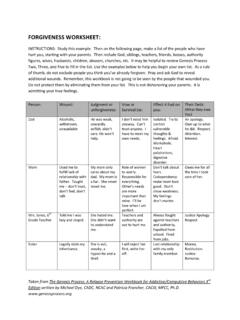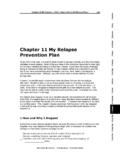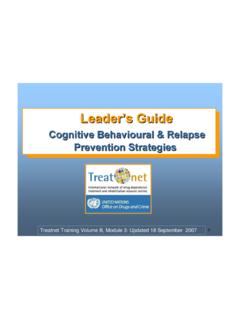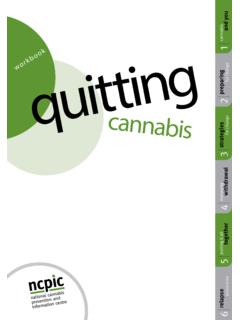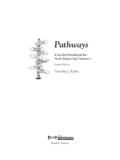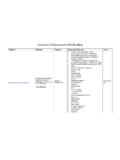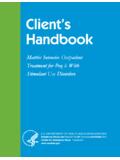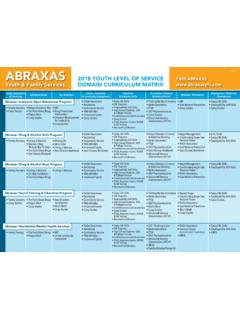Transcription of RELAPSE PREVENTION WORKBOOK - sygdoms
1 RELAPSE PREVENTION WORKBOOK Bradley A. Hedges, , LPCC Psychologist Mid-Ohio Psychological Services, Inc. 624 East Main Street Lancaster, Ohio 43130 (740) 687-0042 12/01/2012 Copyright 1999 Limited permission is granted for the free distribution of this WORKBOOK to treatment programs operating in institutions of the Ohio Department of Rehabilitation and Correction.
2 Other distribution of this WORKBOOK without the author s written permission is strictly prohibited. INDEX Introduction .. 1 Definitions .. 1 The RELAPSE Process ..2 WORKBOOK Overview .. 5 Section A--Identification of Deviancy .. 6 Section A Worksheet .. 10 Section A (Addictive Behavior) Worksheet .. 60 Section B--Modifying Behavior .. 74 Theme Feelings .. 75 Theme Thoughts .. 82 Rituals ..87 High Risk Situations ..93 Cost/Benefit Matrix ..101 Section C--Maintaining Adaptive Behavior ..111 Developing A Support Network ..111 Ongoing Monitoring ..116 Appendix A--The RELAPSE Syndrome ..122 Appendix B--The Addictive System ..126 Ordering Information .. RELAPSE PREVENTION WORKBOOK Revised 12/01/2011 Introduction RELAPSE PREVENTION is both the goal of all treatment as well as a specific intervention modality. This WORKBOOK is designed to help you in your program of recovery by guiding you through the development of a first draft of a RELAPSE PREVENTION plan.
3 RELAPSE PREVENTION was originally developed as a method of enhancing maintenance of change by clients who have been in treatment for compulsive behavioral disorders. RELAPSE PREVENTION was designed to strengthen self management by providing clients with methods for identifying problematic situations, analyzing those situations, and developing strategies to avoid, or cope more effectively with these dangerous circumstances. RELAPSE PREVENTION can theoretically be understood from two perspectives, The RELAPSE Syndrome, and The RELAPSE Process. The RELAPSE Syndrome presents a cluster of predictable and clinically significant behaviors that predictably lead to RELAPSE . Appendix A of this WORKBOOK provides a brief overview of the RELAPSE Syndrome and provides likely solutions to the targeted behaviors. Although this syndrome is well researched and well known, it is difficult to implement a specific plan of recovery which addresses an individual=s needs.
4 This WORKBOOK will focus on the RELAPSE Process which will be explained below. The overall goal of RELAPSE PREVENTION is to increase your awareness and range of choices concerning your behavior, to develop specific coping skills and self-management abilities, and to create a general sense of manageability to your life. To achieve these goals, you will be asked to take a thorough look at your offense and other problematic behavior, explore further your personal characteristics, and develop specific plans for alternative behavior. Your RELAPSE PREVENTION plan should become an evolving recovery maintenance plan that you update on a continual basis. It is not a document that you complete once and file away. In fact, the final written document is not nearly as important as the process you experience in completing the plan. This is a process that you will need to continue to practice throughout your lifetime if you are to maintain abstinence from your abusive behavior.
5 Definitions: RELAPSE --A RELAPSE can be defined as a return to behavior which has been previously stopped. For the alcoholic, a RELAPSE means drinking alcohol again. For the cocaine addict, a RELAPSE is the use of cocaine again. For the sexual offender, a RELAPSE is a return to the abusive sexual behavior. RELAPSE PREVENTION helps you identify the process of RELAPSE and helps you to develop coping skills to implement before your RELAPSE process progresses to the point of a full RELAPSE . RELAPSE PREVENTION WORKBOOK Bradley Hedges Page 2 Lapse--A lapse can be thought of as a failure to implement an appropriate coping skill when you have experienced a feeling, thought, or ritual associated with your addiction. A lapse is very different from a RELAPSE in that you have not returned to the abusive use of the substance/behavior--you have just gotten closer to abusing. If you do not utilize healthy coping skills when faced with a lapse, you are much more likely to RELAPSE .
6 The further along in the RELAPSE process you go, the more difficult it is to implement coping skills and thus avoid a full RELAPSE . Linkages--In the past, you probably associated your abusive behavior with a set of life experiences including people, places, feelings, thoughts, and rituals. Some of these experiences were directly connected to your addiction. For example, if you smoke cigarettes, you can probably identify several experiences such as finishing dinner, getting up in the morning, taking a break with your friends at work, or talking on the phone as directly related to increased cravings for cigarettes. These experiences which are closely connected to your addiction are called direct linkages. Unfortunately, many other experiences are less easily identified as being connected to your addiction but result in just as powerful of a craving/desire to return to your addiction.
7 These experiences are referred to as remote linkages. High Risk Situations--We can plan for direct linkages by identifying the connection between the linkage event and the addiction. We can then either avoid the linkage event or substitute a healthier behavior for the addictive behavior. For example, in the case of people who are addicted to cigarettes, we can suck on a sucker after dinner or we can take our work breaks in another location rather than going outside with our friends who are smoking. When we put ourselves in contact with a direct linkage we are in what is generally referred to as a high risk situation. Avoiding high risk situations is the basis for the old AA saying, Dry faces, dry places. Although it is important to avoid contact with high risk situations throughout your recovery, it is absolutely essential to avoid high risk situations early in your recovery.
8 Avoiding high risk situations generally requires a change in lifestyle which takes you away from the environment where you use to carry out your addiction. This is often a painful process which leaves us feeling alienated from our friends and families. But as most recovering addicts can attest, this is an essential part of recovery. The RELAPSE Process Although avoiding high risk situations is an important part of recovery, few addicts return to their addiction purely due to being in a high risk situation. Unfortunately, most addicts return to their addiction due to remote linkages. And as you might guess, remote linkages are much more difficult to identify than direct linkages. Remote linkages are best understood as a combination of feelings, thoughts, and ritualized behaviors that are subtly connected to your addiction. In order to identify your remote linkages, you must look carefully at your pattern of abusive behavior and you must be very honest with yourself about what you were experiencing when you were participating in your addiction.
9 You must be willing to look at the experience that you were trying to avoid when RELAPSE PREVENTION WORKBOOK Bradley Hedges Page 3 you were active in your addiction. To develop appropriate coping skills means to learn to deal with these experiences without the use of your addictive behavior. The following flowchart describes the RELAPSE Process. We begin by being safe in our environment. We then encounter some change in our personal reality. Some linking event occurs and we respond by experiencing a feeling. If we cope with this feeling well, we return to safety. If we do not cope with the feeling appropriately, we lapse. When we lapse, our thought process is effected. If we cope well with these thoughts, we are generally able to return to safety. If we do not deal well with these thoughts we lapse and end up in a high risk situation or enter into a pattern of ritualized behavior associated with our addiction.
10 If we cope well with the high risk situation/ritual, we return to safety. If we do not cope well, we RELAPSE and return to our abusive behavior--experiencing an acute RELAPSE . RELAPSE PREVENTION WORKBOOK Bradley Hedges Page 4 THE RELAPSE PROCESS Linkage (direct/rem ote)FeelingsThoughtsRitual/ High Risk SituationAcute RelapseCopeCopeCopeNoNoNoYesYesS afetyYes RELAPSE PREVENTION WORKBOOK Bradley Hedges Page 5 WORKBOOK Overview The following WORKBOOK is designed to help you establish a plan for RELAPSE PREVENTION . By identifying your feelings, thoughts, ritualized behavior, and high risk situations you will be able to identify many of your remote linkages relating to your abusive behavior. You will then be asked to develop several coping skills for each of these linking conditions. Finally, you will be asked to begin implementing these coping skills in your day to day life.

